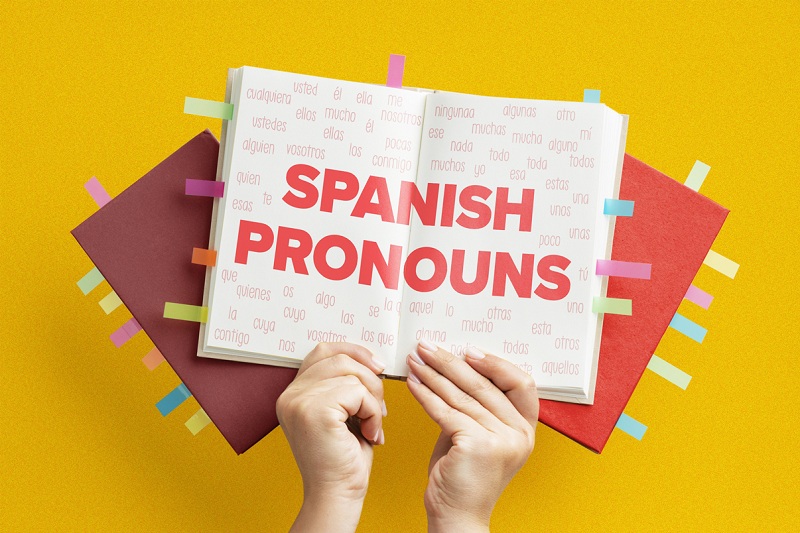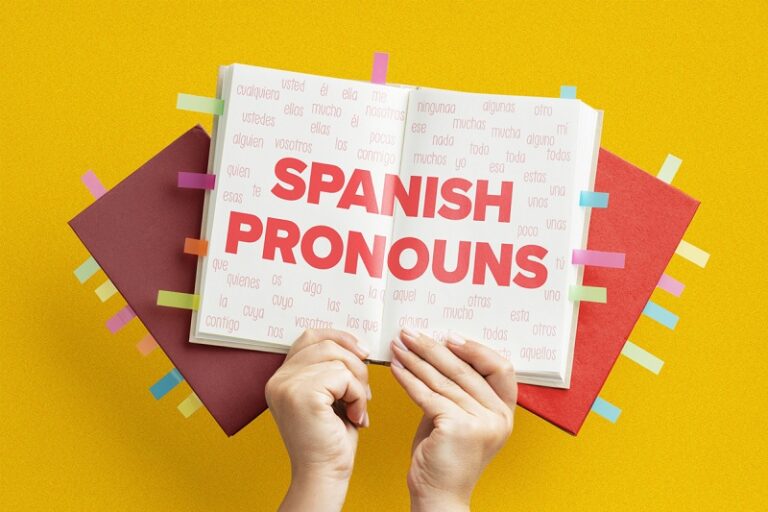
Imagine a world where there were no possessives.
Imagine if you referred to others as just “other,” and not he, she, we, you, they.
Well, it doesn’t matter: because just like making adjectives agree, and the verbs ser and estar, pronouns are part of your everyday Spanish life.
So what exactly are Spanish pronouns, and what’s their deal?
Contents
Download:
This blog post is available as a convenient and portable PDF that you
can take anywhere.
Click here to get a copy. (Download)
What Are Spanish Pronouns?
Pronouns are small words that take the place of nouns and make things more concise, so you don’t have to continue saying someone’s name over and over again.
For example, instead of saying:
Juan es alto. Juan es guapo.
(Juan is tall. Juan is handsome.)
We can instead say:
Juan es alto. Él es guapo.
(Juan is tall. He is handsome.)
However, there are several different types of Spanish pronouns and it’s important to know how to use them properly to avoid confusion.
Trust me when I say that getting your head around Spanish pronouns will make your Spanish life much easier (and faster).
9 Different Types of Spanish Pronouns
1. Subject Pronouns
The subject of a sentence is the person, place or thing that is linked to your main verb. It’s the most important noun in your sentence.
Take the phrase Juan es alto (Juan is tall): Juan is our subject and es (from ser) is our verb.
In order to avoid repeating the name of our person, place or thing (in this case, Juan) over and over again, we use a subject pronoun to replace it.
This post can show you more about Spanish subject pronouns, but here are some main points to keep in mind:
- You may have noticed that Spanish has more than one type of “you.” There’s a difference between formal and informal as well as singular versus plural, which you can read about here if you’re not familiar
- Also, be careful that you add the accent to él and tú: this way, you’ll say “he” instead of “the” (el), and “you” instead of “your” (tu)
- Spanish also has some pronouns to say the word “it,” however they very rarely used. But for the sake of completeness, they are: él (“it” masculine), ella (“it” feminine) and ello (“it” neutral)
2. Direct Object Pronouns
In order to understand this type of pronoun, we need to know what the object of a sentence is.
Remember that the subject of a sentence is the person, thing or place that is directly linked to the verb. Well, the object of the sentence is the thing or person that receives the action of the subject.
So in the example “Juan hit the ball” (Juan golpeó la bola), Juan is the subject and the ball is the object.
Again, in order to avoid repetition, we often use a direct object pronoun.
In English these are the same as the prepositional object pronouns, which is why English speakers often mix up the two in Spanish.
So, let’s say we ask where the ball is:
¿Dónde está la bola?
We then can answer using a direct object pronoun, since the speaker already knows we are referring to the ball:
Juan la tiene. (Juan has it.)
This is easier than saying “Juan tiene la bola.” Note that the direct object pronoun goes before the verb, not afterwards (another common mistake English speakers make!).
If we’re talking about something masculine, not feminine, like a book, for example, then we need to use the masculine pronoun: lo.
So if Diego has the book, we could say, “Diego lo tiene.” (Diego has it.) If Diego has more than one book, we make our pronoun plural: Diego los tiene. (Diego has them.)
3. Indirect Object Pronouns
An indirect pronoun tells us where the direct object is going (to whom?/for whom?).
Let’s look at the sentence: “Juan gives the ball to Laura.” (Juan da la bola a Laura).
What’s our subject? Juan.
What’s our direct object? The ball.
And where is our direct object going? To Laura. So she must be our indirect object!
In some sentences, our direct object isn’t explicit, like in the sentence, “Diego le contó” (Diego told her/him). We have both a subject (Diego) and an indirect object (her/him), but we don’t know what the direct object is.
We have to assume that the answer is “it,” or a juicy secret about Juan.
So what are the indirect object pronouns?
4. Prepositional Object Pronouns
These pronouns are used after prepositions such as for, with, from, without, etc.
A quick note on mí: it’s important to remember the accent on this word or you’ll be saying mi (my) instead. Mí also often gets confused with yo as Spanish uses “I” and “me” differently than English.
For example, if a teacher asked, “Alguien robó mi libro, ¿quién fue?” (Someone has stolen my book, who was it?), the perpetrator should say “Yo” (I) and not mí (me).
Another rule to remember is that after the preposition con, the rules change ever so slightly:
- Con mí becomes conmigo
- Con ti becomes contigo
For example, “Come with me” would be “Ven conmigo,” and “He wants to go with you” would be “Él quiere ir contigo.“
5. Reflexive Pronouns
Reflexive verbs are a common source of grievance for beginners as they add an extra dimension to the verb, but they are actually pretty simple.
For example, when you say, “Se llama Diego” (His name is Diego), you are using the reflexive verb llamarse (to call oneself).
Reflexive verbs always end in –se in the infinitive. When you conjugate the verb, you need to drop the se from the end of the verb, and put it before the verb.
You may or may not change the se to another reflexive pronoun, depending on who you’re talking about.
The different reflexive pronouns are:
Think back to some of those first Spanish verbs you ever learned, like vestirse (to dress oneself, aka to get dressed), peinarse (to brush/to comb oneself) or ducharse (to shower/to shower oneself).
You might say something like, “Me ducho por las mañanas antes de vestirme” (I take a shower in the morning before I get dressed), and you would be using reflexive pronouns without even realizing it.
6. Relative Pronouns
Relative pronouns are words or phrases that refer back to a noun previously mentioned. In English, they’re words like “who,” “whom,” “whose,” “which,” “that,” “what,” “where” and “when.”
Here are some relative pronouns you’ll need to use in Spanish:
Note that some of these change based on gender and number.
Also, it’s not possible to omit the relative pronoun in Spanish. In English, you could say “The car (that) you crashed was new.” In Spanish, you cannot omit the “that,” and you have to say “El auto que chocaste era nuevo.”
More on these pronouns can be found here.
7. Possessive Pronouns
Possessive pronouns each have four forms: the masculine and feminine forms in both plural and singular.
They are always used with the definite article “the” (el, la, los, las) and are:
The possessive pronouns work much like their English counterparts, so in answer to “¿De quién es este auto?” (Whose car is this?), you might say “Es mío” (It’s mine) or “Es nuestro” (It’s ours).
The form of the possessive pronoun must match the noun it’s replacing. So in the above example, the noun we are talking about is el auto, which is why the possessive pronoun is singular and masculine.
Be careful not to mix up possessive pronouns with possessive adjectives, which mean the same as the possessive pronouns in English: my, your, his/her/its/ours/yours/theirs, but are slightly different in Spanish.
For example, “My girlfriend is pretty” translates to “Mi novia es guapa.” In this case, “my” is a possessive adjective because it’s describing a noun (girlfriend).
Now if you say “La tuya no es guapa.” (Yours isn’t pretty), “yours” takes the place of “girlfriend” and uses a possessive pronoun.
This post can show you even more about possessive pronouns.
8. Indefinite Pronouns
Indefinite pronouns are pronouns where the thing we’re talking about isn’t clear.
In English, they are words like “somebody,” “nobody” and “anybody.” In Spanish, they’re the same, just translated.
If you want to know more about indefinite pronouns, check out this post.
9. Demonstrative Pronouns
The only other type of pronoun that you could possibly need are demonstrative pronouns.
These are the equivalent of “this/that/these/those one/s” in English, and in Spanish are:
These demonstrative pronouns are the same as the demonstrative adjectives, but they replace, rather than describe a noun.
Other demonstrative pronouns that don’t change according to gender or whether they’re plural are esto (this matter/this thing), eso (that matter or that thing) and aquello (that matter/thing over there).
For example, you might say:
Esto es muy difícil.
(This is very difficult.)
What to Know About Spanish Pronouns
Pronoun Placement in a Sentence
You might know all the pronouns but they won’t be of any use to you if you don’t know where to stick them in a sentence. Here are some ground rules for pronoun placement in Spanish:
- Subject Pronouns: Subject pronouns can be omitted entirely—they’re typically used for emphasis or clarification, as the verb conjugation already indicates the subject. They usually come before the verb.
Example: Yo hablo español. (I speak Spanish.)
- Direct Object Pronouns: Direct object pronouns replace the direct object of a verb and are placed before the verb.
Example: Lo vi ayer. (I saw him yesterday.)
- Indirect Object Pronouns: Indirect object pronouns replace the indirect object of a verb and also show up before the verb.
Example: Le dije la verdad. (I told him/her the truth.)
- Reflexive Pronouns: Reflexive pronouns indicate that the subject performs the action on themselves. They generally come before the verb.
Example: Me lavo las manos. (I wash my hands.)
- Pronouns with Infinitives: When a pronoun is used with an infinitive verb (that is, an unconjugated one), it can either be attached to the end of the infinitive or placed at the beginning of the sentence.
Example: Voy a hacerlo. or Lo voy a hacer. (I am going to do it.)
- Pronouns with Gerunds: When a pronoun is used with a gerund (the “-ing” form of a verb), it can either be attached to the end of the gerund or placed before it.
Example: Estoy leyéndolo. or Lo estoy leyendo. (I am reading it.)
- Pronouns with Commands: When a pronoun is used with an affirmative command, it’s attached to the end of the verb. For negative commands, it’s placed before the verb.
Example: Hazlo. (Do it.) or No lo hagas. (Don’t do it.)
- Pronouns with Compound Verbs: When a verb is formed with an auxiliary verb and a main verb, the pronoun is usually placed before the auxiliary verb.
Example: Me han dicho. (They have told me.)
- Avoiding Confusion: In order to avoid confusion or ambiguity, Spanish allows the use of redundant pronouns. This means that both the pronoun and the noun can be used together in a sentence.
Example: El libro, yo lo leí. (The book, I read it.)
It’s important to note that there are additional rules and exceptions depending on the specific verb tense, mood and structure of the sentence.
Using Pronouns Together
What happens if you have both an indirect and a direct object in one sentence? Look at this example:
She gave it to you.
Our subject is “she,” our object is “it” and our indirect object is “you.”
In Spanish, the direct and indirect object must always be placed side by side, with the indirect object first. So in Spanish, the sentence would be:
Ella te lo dio.
We couldn’t say, for example, Ella te dio lo, nor Ella lo te dio.
Things get just slightly modified when you have two pronouns that begin with “l.”
For example, ella les lo dio (she gave it to them) is too much of a mouthful for anyone to bear. But whenever both pronouns begin with “l,” change the first one (the indirect pronoun) to se:
Ella les lo dio → Ella se lo dio.
If you want to read more about how this works, check out our post on using direct and indirect object pronouns together.
Here are a few more tips:
- Pronoun Order: In Spanish, the order of pronouns in a sentence is typically as follows: reflexive pronoun → indirect object pronoun → direct object pronoun (me, te, lo/la, nos, os, los/las).
Example: Me lo dio. (He gave it to me.)
- Indirect and Direct Object Pronoun Placement: When using both an indirect object pronoun and a direct object pronoun together in a sentence, the indirect object pronoun generally comes before the direct object pronoun.
Example: Él me lo dijo. (He told it to me.)
Subject Pronoun Omission
As I mentioned earlier, it’s pretty normal to hear someone in Spanish say a sentence that starts with the verb and doesn’t have a pronoun.
This is because pronouns are sort of seen as irrelevant for the most part—you (usually) know who the subject is based on the verb conjugation.
In fact, it sounds a bit strange if you include pronouns in every single sentence that you say. Especially when it comes to yo, because saying “I” over and over can come across as a bit self-important.
Just remember that you don’t need a subject pronoun to be grammatically correct and it’s often encouraged to leave it out since it makes things faster.
So, instead of saying yo voy a la playa (I’m going to the beach), you would just say voy a la playa.
Pronoun Genders
If you look at the third person pronouns, you can see that él/ellos are used for males and ella/ellas is for females.
If you are talking in the first person plural (nosotros — we), it does change with gender. If you’re in a group of girls, you would use nosotras as opposed to nosotros if you’re in a group of all men or mixed genders.
The same principle applies to vosotras and vosotros, so it’s important to pay attention to what genders are in a group so you can use the correct pronoun.
Yo, tú, usted and ustedes do not change with gender.
Pronoun Formality
Pay attention to the context of a situation, so that you can address someone with the proper pronoun. This is referring to the formal or informal “you.”
If you don’t know someone very well or they are considered to be above you in a social hierarchy, you should use the formal usted (ustedes if there are multiple people).
If you call the wrong person tú, you might find yourself in an awkward situation.
How to Practice Spanish Pronouns
Pretty much all Spanish students struggle with pronouns, so don’t worry too much if you can’t get your head around them the first time through.
For now, here are some great ways to practice Spanish pronouns:
- Write some practice sentences. Try writing them with specific nouns and then substituting the correct pronouns.

- Immerse yourself in Spanish media to hear how pronouns are actually used in real life. FluentU is a helpful resource for this—the language learning platform creates an immersive experience via authentic Spanish video clips paired with interactive subtitles. The clips cover everything from news reports to music videos, and you can follow up the videos with learning tools like flashcards.
- Use online resources for practice exercises and quizzes. This site has some great practice exercises and quizzes, or a quick Google will no doubt leave you with a bunch of other sites!
- Speak with a native speaker and listen to how they use pronouns. Then you can try them out yourself and receive feedback!
Try writing practice sentences with each of these nine types of pronouns so you can really get the hang of it. You can do it!
Download:
This blog post is available as a convenient and portable PDF that you
can take anywhere.
Click here to get a copy. (Download)



